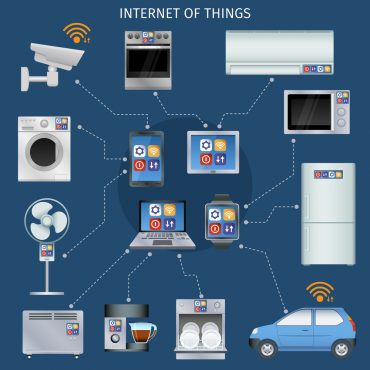
Digital transformation is a challenge for many enterprise decision makers, and IoT efforts can be a great way to begin this transformation journey.
Both B2B and consumer products manufacturers are using sensors, software, and wireless networking to add connectivity to products and differentiate them in the marketplace. In this way, digitalization and the Internet of Things (IoT) are forever changing how we assign value to the products we purchase and use.
Think about this simple example. In 1996, General Motors began offering its onboard OnStar concierge service in Cadillacs. With this technology in place, the way consumers viewed the potential value of their vehicle changed. Sure, they still relied on the vehicle to get from point A to point B. But the connectivity of OnStar also gave drivers peace of mind, a lifeline in case of accidents, and on-demand support to help if the driver got lost or confused.
Today, companies are using IoT to connect everything from jet engines and tractors to refrigerators and electric toothbrushes. But in the process of creating connectivity, we’re doing so much more – we’re creating an entirely new business model that puts us squarely in the realm of Business 4.0
Creating an IoT Value-Generation Loop
IoT is unique from other technology and connectivity advancements because it has made it possible for companies to create a “value-generation loop,” a term we’ve coined at TCS. The value-generation loop is a closed-loop system that enables bi-directional conversations between product developers or manufacturers and end users. Closing the loop and allowing customers, and the products themselves, to share data back with developers and manufacturers is the best way to collect intimate knowledge about how end-users are finding, evaluating and using products on a day-to-day basis.
See also: Early wins for IoT include supply chains, customer service
Creating this closed-loop relies on connectivity technologies such as IoT. But it enables real-time aggregated or personalized feedback on product usage, location, movements, behaviors, user data, connected systems, and a vast number of other metrics. This type of data provides companies with information on how they can modify products, functionality, accessibility, services and other offerings to improve end-user satisfaction.
Ultimately, insights gained from creating a value-generation loop allow companies to not only refresh offerings continuously based on user feedback, but also transform their foundational business model. In essence, they enable a shift from product selling alone, to selling products as services – or selling “value.” This has become known as servitization.
Servitization – a New Business 4.0 Model
Being able to leverage modern technologies such as cloud computing, artificial intelligence (AI), automation, big data and analytics, and IoT are the indicators of a Business 4.0 company. Each of these can play a part in moving companies toward a servitization model and create new channels for delivery of value to customers.
Servitization helps deliver the exact solution customers need and facilitate it at a fraction of the upfront investment typically required. It can also free customers from the constant need to maintain and service the products they buy, automating the process of maintenance and service requests.
For companies looking to evolve to a servitization model, closed-loop systems truly represent a paradigm shift. It reminds us of something Harvard Business School professor Theodore Levitt wrote 40 years ago: “People don’t want to buy a quarter-inch drill, they want a quarter inch hole.”
A company that pursues servitization as strategy taps into Levitt’s timeless truth. It shifts the primary focus from creating value by making and selling a product to creating value by delivering a desired service through a product. The manufacturer may or may not make money selling the product itself; instead, they make money by providing services embedded in the product.
For example, Rolls Royce is creating jet engines with smart technologies and connectivity that enable them to advise airlines on optimal flight speeds and other operating metrics that produce the lowest fuel costs.
In another example, Cargotec worked with TCS to co-create an IoT platform to collect, store and analyze sensory data from its cargo-handling machinery. The platform offers greater visibility of assets and is the first step in enabling servitization. By creating a closed-loop system, Cargotec now receives machinery data and feedback it never had before. Managers can use the IoT data and machine learning to help customers understand how their cargo handling assets are performing, understand how usage relates to failure rates, and even detect anomalies in transport systems. The value of this information “as a service” for customers puts Cargotec ahead of its competitors.
Enabled with Smart, Connected Products
Contrary to an open-loop system, a closed-loop system enables this direct and ongoing digital link to end customers — whether those are business-to-business buyers, OEMs, partners or consumers. This is especially important in business models where companies sell to OEMs and through indirect distribution channels. So, with all the clear benefits, why aren’t all companies rushing toward servitization?
The Annual Manufacturing Report done in late 2017 in association with The Manufacturer indicates that we’re still in the early stages of understanding how to apply a servitization model. Approximately 44 percent of manufacturers surveyed identified as “beginners” in their understanding and application of servitization. Another 39 percent said they were “intermediate” and only 17 percent said advanced.
That said, IoT and other emerging technologies are making closed-loop systems easier and more economical than ever before. In communications, the new 5G network standard promises much faster transmission of digital data. In computing, public clouds and ever more powerful processing promise to reduce costs associated with storing, analyzing, and gaining insights from customer product usage data.
Four Keys to Digital Transformation
Beyond embracing IoT and the technologies needed for servitization, companies need to look at their own business culture and architecture. Business 4.0 requires new ways of thinking and engaging with employees, partners, and customers. To move more quickly toward servitization, companies should commit to four steps:
Open your minds: Conducting design thinking workshops, which employ both an understanding of IT systems and creative problem-solving exercises, can help employees view issues from a customer standpoint. Allowing these different viewpoints can help develop new ideas for adding value and moving the business toward servitization.
Collaborate internally: Engage executives across functions to discuss customer value. Assign a cross-functional team to assess critical touchpoints in the customer experience, such as point-of-purchase, warranty claims or service reports. Using this insight to create pilot tests of potential new service offerings.
Involve your partners: To overcome channel resistance, companies much reach out to partners and make accommodations. Proof of concept projects can help build evidence to show the value of new models, even with reluctant partners.
Educate your customers: Successful servitization requires a focused education program to help customers, especially consumers, understand the value they receive relevant to price. This can be accomplished more easily by starting out with modest projects that do not require overly complex explanations.
Even though most companies are still in the early phases, they are engaging in discussions around servitization, testing value through pilots and rolling out initial product-based services. Business 4.0 is growing in importance as the new standard for modern, competitive, lean organizations. Those companies that fail to embed services in their products—and don’t deliver the valued experiences that servitization promises—are at risk of being left behind.




























